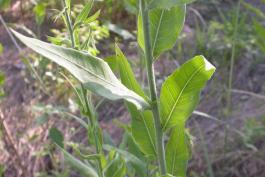
Large-flowered gaura is a tall annual or biennial with an erect stalk, branching near the top, and often hairy stems or leaves. Flowers on long, many-flowered spikes and are 4-parted. The 4 petals are all positioned in the upper half of the flower, opening at dusk, pointing upward and are white at first, turning pink later; they are curved back and about ⅝ inch long; the 8 stamens point forward and curve downward. The overall effect looks like a small butterfly. The stigma has 4 lobes. Blooms June–October. Stem leaves alternate, sessile, lance-shaped with widely spaced teeth, to 4 inches long. Small leaflets arise at the bases of larger leaves.
Similar species: Three other former members of the genus Gaura are known in Missouri: false gaura (O. glaucifolia, formerly G. linifolia), velvety gaura (O. curtiflora, formerly G. parviflora), and scarlet gaura (O. suffrutescens, formerly G. coccinea). Of these, velvety gaura is the most common, being scattered mostly in the western half of the state; its stems are densely haired, and compared to large-flowered gaura, its flowers are smaller and more actinomorphic (radially symetrical as opposed to bilaterally symmetrical).
Height: to 5 feet.

Throughout Missouri except the Bootheel.
Habitat and Conservation
Occurs in open woods, fields, prairies, glades, streamsides, roadsides, and other disturbed sites, in dry or moist areas. This plant can be rather weedy and is often overlooked despite its being rather common.
Status
In 2007, botanists revised the classification for plants in the evening primrose family and mostly eliminated the genus Gaura. This plant had traditionally been in that genus, so many older references call it Gaura longiflora or G. biennis. Many plants have been moved into different groups since the turn of the 21st century, as molecular research uncovers plants’ genetic relationships to one another.
Human Connections
It is common to evaluate plants in terms of their usefulness as food, medicine, sources for dyes, shelter, and landscaping. But we must remember the vast importance of delicate, pretty flowers that bloom without cultivation. They lift our spirits and soothe our souls.
Ecosystem Connections
Bees, especially bumblebees, pollinate the flowers as they drink the nectar. Other insect visitors include several types of moths, some of which use this as their larval food plant. One of these is a noctuid moth, the clouded crimson (Schinia gaurae), which is white and pink like the flowers.































